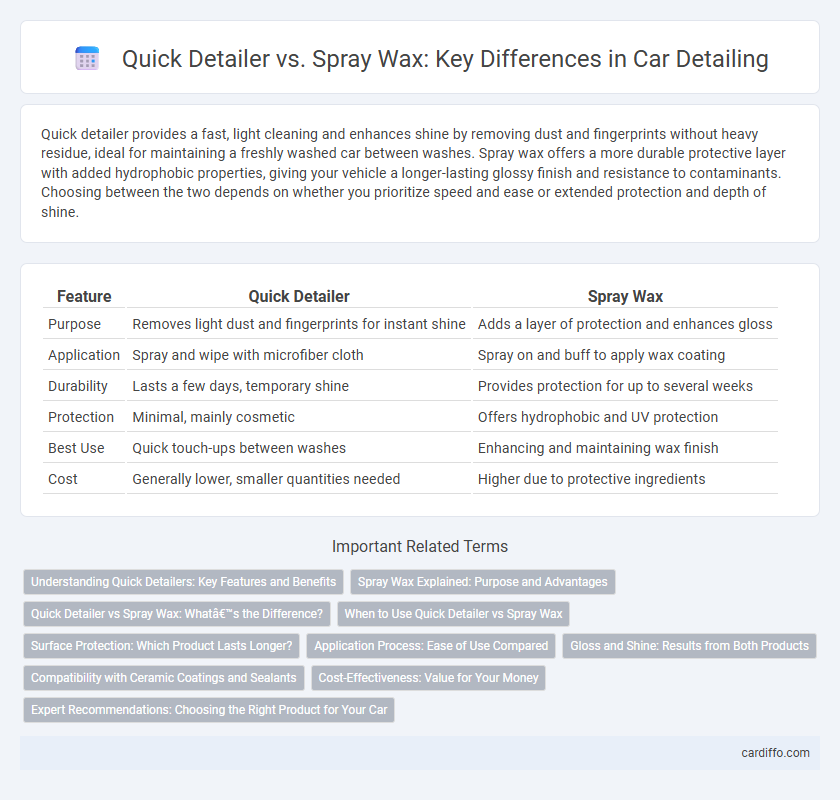Quick detailer provides a fast, light cleaning and enhances shine by removing dust and fingerprints without heavy residue, ideal for maintaining a freshly washed car between washes. Spray wax offers a more durable protective layer with added hydrophobic properties, giving your vehicle a longer-lasting glossy finish and resistance to contaminants. Choosing between the two depends on whether you prioritize speed and ease or extended protection and depth of shine.
Table of Comparison
| Feature | Quick Detailer | Spray Wax |
|---|---|---|
| Purpose | Removes light dust and fingerprints for instant shine | Adds a layer of protection and enhances gloss |
| Application | Spray and wipe with microfiber cloth | Spray on and buff to apply wax coating |
| Durability | Lasts a few days, temporary shine | Provides protection for up to several weeks |
| Protection | Minimal, mainly cosmetic | Offers hydrophobic and UV protection |
| Best Use | Quick touch-ups between washes | Enhancing and maintaining wax finish |
| Cost | Generally lower, smaller quantities needed | Higher due to protective ingredients |
Understanding Quick Detailers: Key Features and Benefits
Quick detailers are lightweight formula sprays designed to remove light dust, fingerprints, and water spots while enhancing a vehicle's shine and hydrophobic protection. They contain lubricants that minimize swirl marks during application, making them ideal for touch-ups between washes without stripping wax or sealant layers. Using quick detailers regularly maintains paint clarity and extends the life of existing protective coatings, ensuring a consistently polished finish.
Spray Wax Explained: Purpose and Advantages
Spray wax provides a durable protective layer that enhances paint shine while repelling water, dirt, and UV rays. It combines the ease of use found in quick detailers with long-lasting wax benefits, offering better protection against environmental contaminants. This product is ideal for maintaining a glossy finish between full wax treatments without extensive application time.
Quick Detailer vs Spray Wax: What’s the Difference?
Quick detailers primarily offer surface cleaning and light protection by removing dust and fingerprints without leaving residue, making them ideal for maintaining a freshly washed car. Spray wax combines cleaning properties with durable wax protection, creating a glossy finish and enhancing paint depth while providing longer-lasting protection against environmental contaminants. Understanding these functional differences helps in choosing between quick detailer for fast touch-ups and spray wax for more comprehensive paint care.
When to Use Quick Detailer vs Spray Wax
Quick detailer is ideal for light cleanups and enhancing shine between washes, providing a swift solution for removing dust and fingerprints on a mildly dirty surface. Spray wax is better suited for adding a protective, glossy layer after a wash, contributing to longer-lasting shine and water repellency. Use quick detailer for daily touch-ups and spray wax for regular maintenance to preserve paintwork durability and depth.
Surface Protection: Which Product Lasts Longer?
Quick detailers offer a fast, temporary shine and light dust removal but generally provide minimal surface protection, lasting only a few days. Spray waxes contain synthetic or natural waxes that create a protective barrier on paint, often extending durability to several weeks. For longer-lasting surface protection, spray wax is the preferred choice due to its enhanced water repellency and UV resistance compared to quick detailers.
Application Process: Ease of Use Compared
Quick detailers offer a faster application process by allowing users to simply spray and wipe off without the need for polishing or buffing. Spray waxes require more effort, often involving spreading a thin layer evenly and buffing to achieve a glossy finish. The ease of use of quick detailers makes them ideal for quick touch-ups and maintaining shine between washes.
Gloss and Shine: Results from Both Products
Quick detailers deliver an instant high-gloss finish by enhancing paint depth with fine polymer coatings, making surfaces instantly reflective. Spray waxes provide a longer-lasting shine by combining waxes and synthetic polymers that create a protective layer while boosting gloss. Both products improve gloss and shine, but spray wax typically offers enhanced durability and deeper luster for extended protection.
Compatibility with Ceramic Coatings and Sealants
Quick detailers are formulated to safely enhance shine and remove light dust without compromising ceramic coatings and sealants, making them highly compatible for regular maintenance. Spray waxes often contain polymers or natural waxes that can offer a temporary protective layer but may interact with certain ceramic coatings, potentially affecting their durability. Choosing a quick detailer designed specifically for ceramic coatings ensures optimal longevity and preservation of the hydrophobic properties of the protective layer.
Cost-Effectiveness: Value for Your Money
Quick detailers offer a budget-friendly solution by providing fast cleaning and shine with minimal product use, ideal for maintaining a vehicle between washes. Spray waxes, while slightly more expensive, deliver longer-lasting protection and deeper gloss, enhancing paint durability and reducing future maintenance costs. Evaluating quick detailer versus spray wax cost-effectiveness depends on frequency of use and desired level of finish, with spray wax yielding higher value for extended paint protection.
Expert Recommendations: Choosing the Right Product for Your Car
Expert recommendations emphasize selecting a quick detailer for rapid cleaning and enhancing shine without wax buildup, making it ideal for regular maintenance. Spray wax is favored for long-lasting protection and a deeper gloss, suited for cars stored outdoors or exposed to harsh elements. For optimal results, detailers advise using quick detailers between washes and spray wax during routine waxing schedules to balance convenience and durability.
Quick detailer vs Spray wax Infographic

 cardiffo.com
cardiffo.com